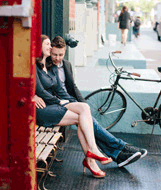24 Mar
ISO
Do you remember going to the store and looking at rows and rows of Kodak or Fujifilm for your film point-and-shoot cameras? You might have called your mom on your brand new cell phone and asked “Should I be getting 400 or 800 film?” (I graduated high school in 2003 and this very thing used to happen to me.) The numbers 400 and 800 refer to the ISO of the film.
What does the term ISO mean?
When dealing with film, the term ISO refers to the films sensitivity to light. Now that most of us have moved to digital the definition has changed a little bit (now it refers to the sensitivity of the image sensor) but this “sensitivity” functions the same with regards to your photos whether you are shooting film or digital.
Here is all you really need to know to use your ISO settings effectively: Lower numbers (like 100 or 400) mean less light sensitivity, and a finer grain. Higher numbers (like 800 or 1600) mean more light sensitivity, but also more grain.
What do HIGH ISO and LOW ISO settings look like?
Here is an example of a photograph taken with a very HIGH ISO setting.
See all of those speckles in the photo? (Look in the darker parts of the photo, like the dad’s suit.) That’s called grain.

Here is another HIGH ISO photo example. I wanted to capture the mood of the room with the twinkle lights, and I also like to switch off my flash sometimes and use the drama of a grainy photo captured with a high ISO to help tell the story.

Here is another example taken using a LOW ISO. See the absence of grain? I love how smooth and pretty images with LOW ISO are. (I also love really grainy black and white images like the ones above as well. I’m pretty easy to please.)

Same bride, later in the night. This was taken without any help from my flash, utilizing the high ISO capabilities in my 5dmkii Canon camera.

To try to help you understand how changing the ISO affects how smooth or grainy an image is, I set this toy dog down in a corner by the window and photographed it using 5 different ISO settings. I kept the aperture the same throughout, and chose different shutter speeds for each photo to try to maintain the same exposure for each image. All of these are straight-out-of-camera.
For this first photo, I used the setting of ISO 100. Do you remember what that lower number means? (Hint: Less grain, but also less light “soaked up” into the film sensor.)

All of the photos on the left are a cropped/zoomed-in version of the photo on the right. Scroll down and watch how the amount of grain in the bedspread increases as the ISO number increases.




I think that the difference between a high and low ISO can best be seen when you are photographing people. This time, the image on the left was a bit under-exposed straight-out-of-camera (too dark), so I brightened it a bit using Adobe Lightroom. The image on the left has a high ISO and is filled with those spots of grain. It also has colors that look a bit more muted, and even with a liberal dose of Photoshop they’re still not going to look as smooth and natural as they would with a lower ISO. On the right the photo was taken with a setting of ISO 400, and in the close-up you can see that his skin is nice and smooth.


Fancy dSLRs like mine have ISO settings that go really high (all the way up to 6400 for the Canon 5Dmkii). Most point and shoots or prosumer level dSLRs won’t even go that high. One of the things expensive dSLR cameras are supposed to do is eliminate the film grain (sometimes called noise) as much as possible, so the HIGH ISO setting photos on my camera don’t have as much noise as the photos taken with a less expensive camera might. The more expensive your camera is (generally) the less grain you will have in your photos.
What I’m trying to get across here is that my camera at ISO 1600 will have much less noise than a point and shoot set to ISO 1600. This is one of the reasons that professional cameras cost more than consumer camears.
What are some examples of situations where I would need to consider using a higher ISO (more light being “soaked up” into your photos, which means lighter images, but also more noise)?
From Digital Photography School blog:
Situations where you might need to push ISO to higher settings include:
- Indoor Sports Events - where your subject is moving fast yet you may have limited light available.
- Concerts - also low in light and often ‘no-flash’ zones
- Art Galleries, Churches etc- many galleries have rules against using a flash and of course being indoors are not well lit.
- Birthday Parties - blowing out the candles in a dark room can give you a nice moody shot which would be ruined by a bright flash. Increasing the ISO can help capture the scene.
It’s important to remember that there are several different settings on your camera that will contribute to photography success. You know how to change the white balance, and now the ISO. Figure out if your camera has a setting that lets you change only the white balance and ISO (“P” or Program might let you do this), and start taking pictures on different ISO settings to get a feel for how the two work together.Once you understand how those two work together, you’ll be all ready to introduce the concept tomorrow’s post, shutter speed, into your bag of tricks!


 I'm a farm-raised almost-crunchy stroller-pushing picture-taking lifestyle-blog-writing gastronomy-obsessed divine-seeking thrift-store-combing cheese-inhaling pavement-pounding laughter-sprinkling lover of individuality and taking chances.
I'm a farm-raised almost-crunchy stroller-pushing picture-taking lifestyle-blog-writing gastronomy-obsessed divine-seeking thrift-store-combing cheese-inhaling pavement-pounding laughter-sprinkling lover of individuality and taking chances.












For the first time in my life I know what ISO is! That was a great post, J - thanks. Are you sure you don’t have some teacher-blood coursing through your veins? You’re really good at it.
1Thanks for the wonderful explanation! You Rock!
2Thanks for sharing! All the other analogies I had read on the interwebs made no sense to me. Now it does! How do you know all this stuff?
3Thanks for sharing this! I’d like to think I know how/when to use the settings, but this is really helpful! Thanks for making us not feel like idiots and take better everyday pictures!
4Jenna, thank you SO much for these posts! You make it much easier to understand than my camera manual does
5Have you ever thought of teaching a class in photography? You explain it so well.
6Thank you so much! I have taken a photography class and have a fiance that takes photographs in his spare time, but this post has finally explained to me what ISO is and MEANS! The pictures showing the differences and suggestions of when to change them are also very helpful. Thanks again!
7Thank you so much for this!
The bulb in my flash recently went out on my camera (so I was told), and would cost a couple hundred dollars to send off and get fixed. (sad - don’t know what I’m going to do yet…probably just replace the camera)
Using a higher ISO might help me instead of having a flash. Maybe?? I know it’s not a total fix, but it can possibly hold me over until I can buy a new camera. I’m crossing my fingers that this works and will try it out tonight!
THANKS AGAIN!
8I’ve found the low ISO setting on my camera and I am in love with it! I can’t wait to play with the white balance settings.
9These posts are so helpful Jenna. Thank you!
Can you elaborate some more on how ISO should be used with moving subjects? I noticed the comment about indoor sports events, but do things like higher ISO settings affect whether or not I should be using a tripod? Or am I confusing film speed and shutter speed?
Jenna Reply:
March 24th, 2009 at 9:42 pm
Actually, movement is more of a shutter speed thing, which is what I’ll talk about in tomorrows post!
Hi Jenna, I’m so grateful you’re doing this series. I’ve wanted to learn how to use my camera in a more advanced way, but had no idea how to start, and now I do! I’ve been playing with different white balance and ISO settings today (my dog is loving being my model!).
I do have one question. I tend to keep the auto-flash on, because I don’t know enough about lighting to know when to use it. Not sure if you were planning on doing a separate post about using the flash effectively, but if not, I was wondering if and how the flash affects white balance and ISO? I’m going to keep playing around so I can learn from experience, but you have a knack for simplifying these things, so thought I’d ask. Thanks again
11Thanks so much for doing this little series. I’ve finally broken out my camera manual (‘ve got the Canon 40D) and started to play around with settings. I figured out where the white balance adjustment was and have begun using it. Thanks so much!
12I just love all of the photography tips that you are providing here! You do explain it so well! I look forward to tips on Lighting!
13This post is so helpful! Many thanks!
14Your photography tutorials are great! I just bought a Nikon D5000 and I have an understanding of what these things are, but you are helping me to really grasp it! Thank you so much.
15